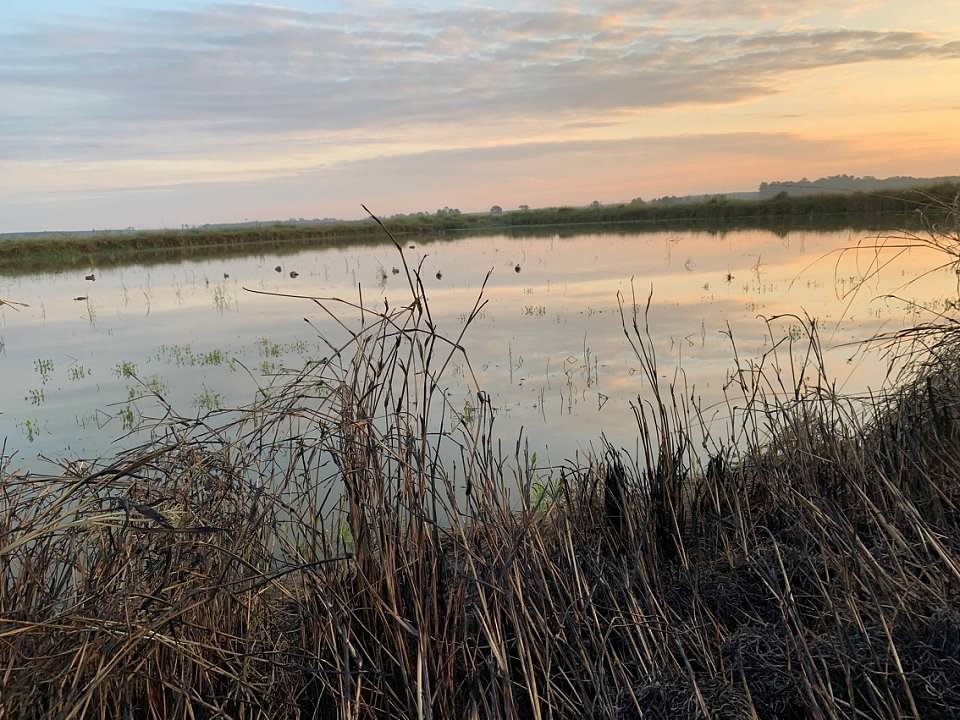Special Note: I learned from a reader that they stopped getting emails alerting them of new postings. I researched and found that Blogger stopped offering this service. You can no longer subscribe. Save our website to your favorites and check in with us daily for new posts. I normally try to post on Sundays, Mondays, Wednesdays and Thursdays - usually between 9 and 10 pm. We so appreciate your readership.
This post needs a sub-heading. "Not Much Meat For the Gumbo" sounds like a good description. It was opening day for teal season. I logged onto the Louisiana Department of Wildlife and Fisheries website and purchased a resident hunting license for $20, a resident waterfowl license for $12 and a Federal Duck Stamp for $25. I printed them out and carefully folded them in my wallet in the event we're visited by a game warden bright and early Saturday morning.
I set my alarm for 5 AM. I had talked to my buddy, Gary, and was to meet him at the farm at the air strip at 6 AM. That would give us ample time to get situated in the blind prior to sunrise. Gary and I carried our shotguns and five gallon buckets down to the duck blind. We turn the five gallon buckets upside down and sit on them. They also are helpful in carrying out the game we kill. Gary had gone out a few days prior and set out the decoys. The pond is in a cut in a rice field that we had stopped up to save rain water. As the sun began peeking up in the east, you could see the decoys bobbing in the water.

It was partly cloudy, with a gentle breeze. Actually, quite cool for this time of year at 70 degrees. Mosquitoes buzzed around us in thick clouds. I began slapping my neck. Gary passed a can of Deep Woods Off to me. We heard shotgun blasts from other blinds in the distance as the time of official sunrise passed. My Dad was hunting with my nephew and his friends not far from us. Neighboring farmers were scattered in blinds adjacent to us. Mexican squealers, crooked beaked cranes and cattle egrets flew by.
The ducks were coming in slowly - one or two at a time. Some would cup their wings and land amidst the decoys. Bigger flocks flew higher overhead. Some groups circled our pond and then changed their minds and flew away. Gary and I took shots when we had them. Some of our shots were true. Some were hopeful at best and fired when the teal were well out of range. I thought I saw a teal look back at us and wink.
Gary and I use the occasion to catch up. He's a good friend and we don't get to spend the time that we ought to. We talk about family and work and the things you normally talk about like life, health, and memories of times we shared when we were younger and worked together. In retrospect, some of this talking likely scared some of the teal away, I'm sure.
About 8:15 AM the ducks stopped flying. The sounds of shotgun blasts from other ponds stopped. We walked out to the pond and retrieved our ducks. Sadly, Gary killed one and I killed one. We missed four or five. Not a very successful hunt, if you gauge it by the weight of your game bag, but we enjoyed ourselves. Dad, and the other three in his blind killed 10. Here's Gary with our two birds.
And here's me with the teal.
Gary was going to bring his daughter out hunting Sunday morning, but I told him I'd meet him next Saturday. I'm waiting on a report to see how many they got. With only one bird, it didn't make sense to get out the crawfish boiling pot I use to scald them or the big plucker we use when we butcher chickens. I just decided I'd scald them on the kitchen stove. It might have been my imagination, but I thought I sensed displeasure from my wife in this decision.
Once the water got to 145 degrees, I began dunking the bird. You can see why they are called blue-winged teal, can't you? I plucked the teal in the kitchen, being ever so careful to put every single feather in the five gallon bucket that had served as my seat in the duck blind.
I had sharpened my knife while waiting on the water to boil. I took the teal outside to gut. I certainly didn't want to push my luck. Tricia sat out with me while I cleaned the teal. It didn't take long. In no time I had the teal cleaned along with the gizzard, the liver and the heart.
Not much meat for the gumbo, but that was only day one. I'll get more. We can always "stretch the pot" with some sausage, too.